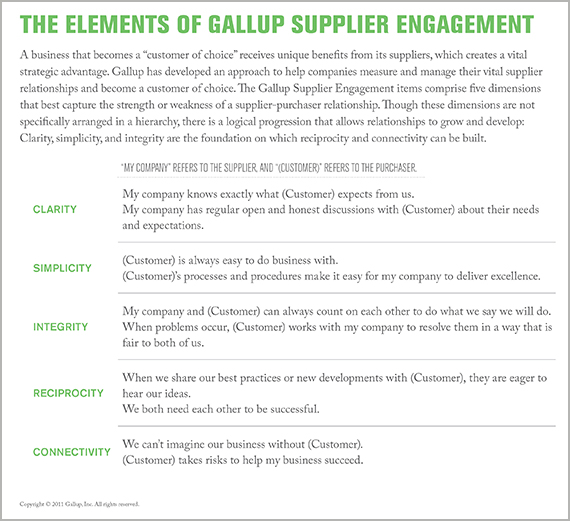Story Highlights
- Trustworthy cooperation is key for companies and their suppliers
- Many companies don't know whether they're a customer of choice
- There are three key factors to becoming a customer of choice
A company is very fortunate if it has good, trustworthy suppliers. Ongoing delivery of high-quality, reliable products at reasonable prices helps ensure smooth operations, productivity and success of the company's products in the market.
But know this: Good suppliers want your company to treat them with respect. Yet in many industries, companies see suppliers as cost factors that they need to manage rather than as key partners that can make or break the success of the business.
A U.S. auto manufacturer is learning this lesson the hard way. In one of the largest recall campaigns in automotive history, millions of vehicles were recalled because of defective starter switches. A key reason for this quality defect was the company's demand that its suppliers produce their products at Chinese price levels.
Companies that merely try to get cheaper deals from their suppliers can't expect preferential treatment for product or process quality. Businesses that constantly change their suppliers to find the cheapest deal possible can't expect their suppliers' unwavering support in crisis situations. And companies that don't have a close relationship with their suppliers won't be first in line to receive major innovations or important new products.
Becoming a Customer of Choice
On the other hand, companies and suppliers can mutually benefit from a close and trustworthy cooperation in the supply chain. It's often preferable to involve suppliers early when developing new products or services to benefit from their knowledge and innovative strengths. Ultimately, the aim is to become a true "customer of choice" -- at least with your most important suppliers.
Not every supplier relationship has the same value for a company or is equally necessary for the business' survival. For example, a key supplier that's a highly specialized manufacturer with few competitors could have a significant impact on your business. This supplier should receive more attention than service providers with a high number of competitors and a lower risk potential, such as a supplier of office supplies.
Achieving a customer-of-choice status differentiates your company from its competitors and gives it a decisive competitive advantage. This is especially valuable in crisis situations, when your company needs flexible and non-bureaucratic support from its suppliers. Suppliers devote their full attention to a customer of choice and ensure that the best employees are working on these customers' projects. A customer of choice is likely to get access to cutting-edge processes and technologies from suppliers, which can help the company develop new products and bring innovations to the marketplace faster. And last but not least, a customer of choice gets more favorable terms than a competitor without this status.

Measuring Supplier Relationships
Despite all of this, too many companies don't know whether they are a customer of choice with their key suppliers -- or what they can do to become one. Until now, there was no systematic, viable approach to measure the quality of supplier relationships and to start a dialogue between companies and their suppliers about the results. To develop an easily manageable way to measure, manage and improve the quality of supplier relationships, Gallup collaborated with Mars, a leader in fast-moving consumer goods.
Mars and Gallup began their work on supplier engagement as a result of Mars' experience with a strike in France. Gasoline stations across the country were closed, but one important supplier still had one truck with fuel available. Several customers fought over who would receive the truck -- it could go to only one company. In the end, one of Mars' competitors received the truck, and Mars was forced to reduce production in one of its plants. As a result of this, Mars approached Gallup with an important question: "What can we do to become a customer of choice?"
Gallup started its search for the answer to Mars' question by assuming that the same rules and best practices apply to managing supplier relationships as to managing employee and customer engagement. To create supplier engagement, companies must understand both the rational and emotional elements of engagement. The quality of the relationship is determined by not only hard factors, such price, quality and physical availability, but also through the interactions between suppliers and customers.
Based on Gallup's many years of experience in measuring and optimizing employee and customer engagement in companies worldwide, Gallup identified five core dimensions and 10 survey items that determine the quality of supplier relationships.

Creating an Ongoing Dialogue With Suppliers
The Gallup Supplier Engagement survey offers an ideal opportunity to initiate a dialogue with suppliers. Though it's unusual to give suppliers an opportunity to rate their customers, it's one that a majority of suppliers view positively. A typical supplier response to this opportunity is something like, "My customer appreciates me, he listens to me and I know that I'm important to him."
Gallup reports the survey results by product categories; if there are a sufficient number of responses, Gallup can assign results to a specific buyer at the customer company. Because evaluations of individual buyers can vary widely every buyer's interactions with a supplier shapes the quality of that supplier relationship. Training and coaching buyers on behaviors that can improve supplier relationships is crucial to becoming a customer of choice.
Since Mars implemented its supplier engagement program, collaboration between suppliers and Mars has improved significantly in many areas. The following are some examples of these improvements:
- When answering the Supplier Engagement survey, a supplier described the ordering process at one of Mars' European business units as too complicated. During a joint meeting between Mars and the supplier, the companies clarified their structures, identified and overcame several misunderstandings, and identified contact people. Since then, the supplier has become much more flexible in accommodating last-minute orders.
- In another example, the process identified high error rates in forecasting supply needs from a key supplier. Follow-up discussions between Mars and the supplier determined that poor communication between buyers and the supplier was one source of the forecasting problems. The problem was solved by implementing a sharing platform, which quickly resulted in a significant improvement in storage optimization and liquidity management. The supplier now feels better informed and is more willing to respond to unexpected ad hoc requests from Mars.
- In another case, a Mars office needed the support of a particular supplier to meet a key supply need. The supplier was unwilling to support Mars because of fears that support would harm relations with another customer. During follow-up conversations, the team at Mars recognized that the supplier didn't understand the decentralized procurement process Mars used. To help the supplier gain a better understanding of Mars' business strategy, Mars arranged a factory tour and a visit to a research facility. After gaining a better understanding of Mars' corporate identity, the supplier offered Mars its full support.
These examples demonstrate how ongoing, productive dialogue can create a positive customer-supplier relationship. In some instances, for example, a supplier might have a different perception of risks to its common business relationship than the customer does. An ongoing conversation with suppliers is a way to exchange information and correct perceptions, optimize collaboration and engage suppliers.
Gallup found three key factors in becoming a customer of choice:
- Engage your suppliers. Seek feedback and listen.
- Let your suppliers into the tent. Willingly share information.
- Be easy to do business with. Strive for clarity, simplicity and consistency.
A company that actively works to incorporate these three principles into its business practices is on its best way to becoming a customer of choice.
A version of this article originally appeared in Q1, a magazine published in Germany, Austria and Switzerland that targets quality, production and purchasing executives.
